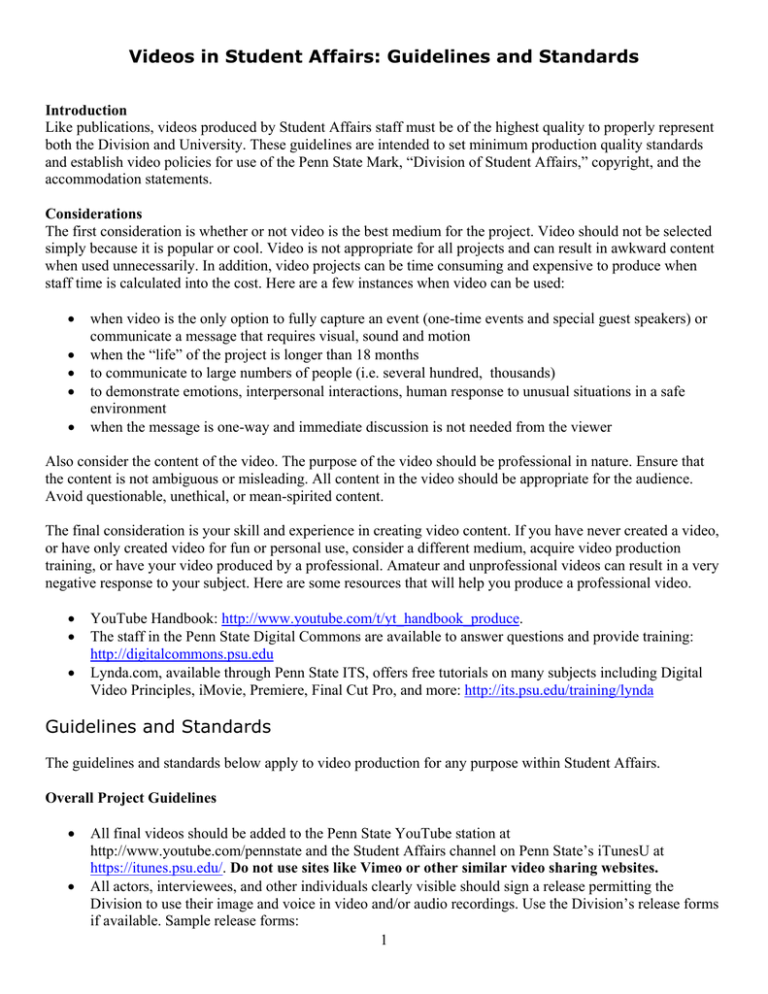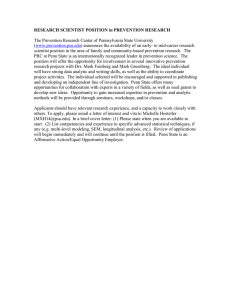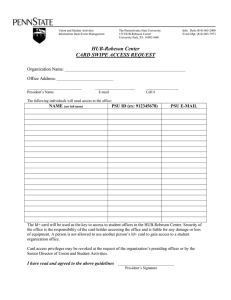
Videos in Student Affairs: Guidelines and Standards
Introduction
Like publications, videos produced by Student Affairs staff must be of the highest quality to properly represent
both the Division and University. These guidelines are intended to set minimum production quality standards
and establish video policies for use of the Penn State Mark, “Division of Student Affairs,” copyright, and the
accommodation statements.
Considerations
The first consideration is whether or not video is the best medium for the project. Video should not be selected
simply because it is popular or cool. Video is not appropriate for all projects and can result in awkward content
when used unnecessarily. In addition, video projects can be time consuming and expensive to produce when
staff time is calculated into the cost. Here are a few instances when video can be used:
•
•
•
•
•
when video is the only option to fully capture an event (one-time events and special guest speakers) or
communicate a message that requires visual, sound and motion
when the “life” of the project is longer than 18 months
to communicate to large numbers of people (i.e. several hundred, thousands)
to demonstrate emotions, interpersonal interactions, human response to unusual situations in a safe
environment
when the message is one-way and immediate discussion is not needed from the viewer
Also consider the content of the video. The purpose of the video should be professional in nature. Ensure that
the content is not ambiguous or misleading. All content in the video should be appropriate for the audience.
Avoid questionable, unethical, or mean-spirited content.
The final consideration is your skill and experience in creating video content. If you have never created a video,
or have only created video for fun or personal use, consider a different medium, acquire video production
training, or have your video produced by a professional. Amateur and unprofessional videos can result in a very
negative response to your subject. Here are some resources that will help you produce a professional video.
•
•
•
YouTube Handbook: http://www.youtube.com/t/yt_handbook_produce.
The staff in the Penn State Digital Commons are available to answer questions and provide training:
http://digitalcommons.psu.edu
Lynda.com, available through Penn State ITS, offers free tutorials on many subjects including Digital
Video Principles, iMovie, Premiere, Final Cut Pro, and more: http://its.psu.edu/training/lynda
Guidelines and Standards
The guidelines and standards below apply to video production for any purpose within Student Affairs.
Overall Project Guidelines
•
•
All final videos should be added to the Penn State YouTube station at
http://www.youtube.com/pennstate and the Student Affairs channel on Penn State’s iTunesU at
https://itunes.psu.edu/. Do not use sites like Vimeo or other similar video sharing websites.
All actors, interviewees, and other individuals clearly visible should sign a release permitting the
Division to use their image and voice in video and/or audio recordings. Use the Division’s release forms
if available. Sample release forms:
1
o
o
•
•
•
http://digitalcommons.psu.edu/files/dcommons/PSUImageRelease.pdf
http://digitalcommons.psu.edu/files/dcommons/PSUBroadcastReleaseForm.pdf
Copyright information for photos, graphics and music must be clearly identified by source. If permission
has not be acquired, then materials cannot be used unless their use is covered under the TEACH Act:
http://tlt.its.psu.edu/dmd/teachact/teachactFAQ.html.
Audio and video quality should be consistent throughout the length of the project.
Audio and video should be free of fuzziness, distortion, blurriness, interruptions, mismatches, etc.
Video Quality Guidelines
•
•
•
•
•
•
•
Video output is to be well lit and should not appear dark on-screen creating difficulty in seeing the
features of the subjects in the video.
All shots are to be clearly focused and well framed. Close-ups should focus attention, not distract the
viewer.
Video output is to be stable, not shaky. A tripod should be used whenever possible to reduce “camera
shake.” If tripod use is not possible, camera shake should be very minimal.
All titles or other text added to the video must be proofread for accuracy and proper grammar.
Misspellings, typos, and poor usage are unacceptable and will require recreating the necessary
section of the video.
Any additional graphics or animations should be professional, appropriate, and necessary for the
message of the video. Graphics and animations must be clean, clear, and undistorted.
All fade in/fade outs, effects, etc. should add to the message of the video and must be smooth, not abrupt
or choppy.
All dead air should be edited out, so the video is seamless from beginning to end.
Video Technical Standards
For videos to be uploaded to YouTube:
•
•
•
•
•
•
•
•
Video Format: H.264, MPEG-2 or MPEG-4 preferred
Aspect Ratio: Native aspect ratio without letterboxing (examples: 4:3, 16:9)
Resolution: 640x360 (16:9) or 480x360 (4:3) recommended
Audio Format: MP3 or AAC preferred
Frames per second: 30
Maximum length: 10 minutes (2-3 minutes recommended)
Maximum file size: 1 GB
Use the embed code in your webpage instead of linking to the video.
Audio Quality Guidelines
•
•
•
•
•
All audio should be consistently audible throughout the length of the project.
All audio files should be clearly understood through the length of the project.
All audio files should be free of background noise, breaks, skips, hissing, etc.
If there is more than one speaker, neither speaker should be noticeably louder than the other.
Intentional background audio should be well-balanced with the primary audio.
2
Audio Technical Standards
Most video programs will handle the audio settings if the sound was recorded with the camera. If the sound
was recorded separately and merged with the video, use the following technical guidelines for compressing
audio:
•
•
•
•
•
Full Resolution-48kHz, 16 bit, Stereo PCM, OK for DVD
YouTube-44.1 kHz, MP3, Stereo
Penn State’s Streaming Server-32kHz AAC, Stereo
PowerPoint (with audio)-48kHz MP3, Stereo, OK for DVD
General Audio Level Recommendations
o Dialogue setting: -6db to -12db
o Sound Effects setting= -12db to -18db
o Music setting= -18db to -30db
Recognition and Credit Screen Standards
All videos must have a Recognition and Credit screen at the end of the video. This page must contain the Penn
State Mark, a copyright statement, recognition of both the unit and the Division of Student Affairs, as well as
the accommodation (Nondiscrimination and ADA) statements. The only exception is for videos that are part of
a learning module or larger program where the information will be provided on the credits page for the entire
module or program.
Use of the Penn State vs. The Pennsylvania State University
• Penn State is the communicative name for the University. All publications originating from Penn State
should use the communicative name rather than the full name. The full name (The Pennsylvania State
University) is reserved for formal documents, legal contracts, some mailing addresses, and form entries.
• Penn State may be referred to as the University after the first mention, but only if you are referring to the
entire institution, not just a single campus, college, or other location.
• It is not acceptable to call the University ‘PSU’ in publications, videos, graphics, or animations.
• To learn more go to: http://ur.psu.edu/stylemanual/editorial/pennstateinfo.html
Use of the Penn State Mark
The Penn State Mark is a registered trademark and may not be modified. It is important to note the Athletics
logos are not interchangeable with the University mark and should not be used to represent nonathletic
programs. These logos include the 1983 Intercollegiate Athletics logo sometimes referred to as the “chipmunk”
logo as well as all of the newer “Pride of Lions” designs. Please use the link below to view acceptable
University Marks as well as acceptable usage guidelines.
http://ur.psu.edu/stylemanual/graphic_identity/grunivmark.html
•
•
Custom size and/or color Marks for graphics and artwork can be obtained from the Multimedia and Web
Services Office in Student Affairs: http://studentaffairs.psu.edu/it/design
Sometimes the Penn State Mark becomes distorted when used in videos. To ensure Penn State Marks
meet University quality standards, you may download ‘video-approved’ marks from the “For Video”
section of the following Website: http://www.personal.psu.edu/staff/d/r/drs18/mark.html
3
Division of Student Affairs and Unit Recognition
All videos must credit the unit that the video was developed for, the Division of Student Affairs, as well as the
University. It should look something like the statement below. If a title is not available for the video, then the
same credit line can be used without the title of the video.
[Title of the video], a production of [unit name], Division of Student Affairs,
Copyright Statements
All videos should have a copyright statement to show ownership of the video. All staff exempt, staff nonexempt, and technical service employees are required to sign an Intellectual Property Agreement as part of their
hiring paperwork. The Agreement states that if materials are developed within the scope of the creator’s
employment within Student Affairs while using University resources, the ownership of the creation (intellectual
property) rests with the University. Please add the statement below to all videos.
The Pennsylvania State University © [Year]. All rights reserved.
Accessibility
When you are distributing University information electronically including video, you must include the
accommodation (ADA and Nondiscrimination) statements. Because video may easily be circulated outside of
the University community, it must include the appropriate accommodation statements (even though it is not a
printed publication). Short or long versions are acceptable.
Nondiscrimination and ADA Statements
Short version:
This publication is available in alternative media on request.
Penn State is committed to affirmative action, equal opportunity, and the diversity of its workforce.
Long version:
This publication is available in alternative media on request.
The Pennsylvania State University is committed to the policy that all persons shall have equal access to
programs, facilities, admission, and employment without regard to personal characteristics not related to ability,
performance, or qualifications as determined by University policy or by state or federal authorities. It is the
policy of the University to maintain an academic and work environment free of discrimination, including
harassment. The Pennsylvania State University prohibits discrimination and harassment against any person
because of age, ancestry, color, disability or handicap, national origin, race, religious creed, sex, sexual
orientation, gender identity or veteran status. Discrimination or harassment against faculty, staff or students will
not be tolerated at The Pennsylvania State University. Direct all inquiries regarding the nondiscrimination
policy to the Affirmative Action Director, The Pennsylvania State University, 328 Boucke Building, University
Park, PA 16802-5901, Tel (814) 865-4700/V, (814) 863-1150/TTY.
Obtaining a U.Ed. Number
All videos produced in the Division must be reviewed and assigned a U.Ed. number by the Division’s U.Ed.
representative. To learn more go to: http://studentaffairs.psu.edu/it/design/ued.shtml
4
Sample of Recognition Screens (short version)
5
Resources
•
•
•
•
•
•
•
Video on the Web http://ets.tlt.psu.edu/learningdesign/webdesign/media/video
Digital Video Project Rubric http://edtech.guhsd.net/video/Assess.htm
David Stong’s website http://www.personal.psu.edu/staff/d/r/drs18/mark.html
YouTube website http://youtube.com
Digital Video Principles http://its.psu.edu/training/lynda
Visual and Editorial Standards http://ur.psu.edu/stylemanual/editorial/index.html
Policy RA11 Patents and Copyrights https://guru.psu.edu/policies/RA11.html#F
Created by April Sheninger, M.Ed., Student Affairs Instructional Designer; Ken Gore, Student Affairs
Multimedia Specialist.
Approved by the office of the Vice President for Student Affairs.
October 2009
For more information, contact:
April Sheninger
222 Boucke Bldg.
University Park, Pa 16802
Phone: 814-863-7800
Email: azs2@sa.psu.edu
6






